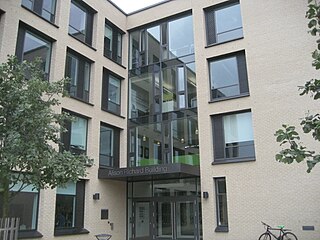
The University of Cambridge is composed of 31 colleges in addition to the academic departments and administration of the central University. Until the mid-19th century, both Cambridge and Oxford comprised a group of colleges with a small central university administration, rather than universities in the common sense. Cambridge's colleges are communities of students, academics and staff – an environment in which generations and academic disciplines are able to mix, with both students and fellows experiencing "the breadth and excellence of a top University at an intimate level".

Corpus Christi College is one of the constituent colleges of the University of Oxford in the United Kingdom. Founded in 1517, it is the 12th oldest college in Oxford.

King's College is a constituent college of the University of Cambridge in Cambridge, England. Formally The King's College of Our Lady and Saint Nicholas in Cambridge, the college lies beside the River Cam and faces out onto King's Parade in the centre of the city.

Corpus Christi College, is a constituent college of the University of Cambridge. From the late 14th century through to the early 19th century it was also commonly known as St Benet's College.

This is a list of halls of residence on the various campuses of the University of Nottingham in Nottingham, England.

Murray Edwards College is a women-only constituent college of the University of Cambridge. It was founded as "New Hall" in 1954. Like most Cambridge colleges, it did not bear a benefactor's name. This situation changed in 2008 following a donation of £30 million by alumna Ros Edwards and her husband Steve Edwards to secure the future of the college as a college at the University of Cambridge in perpetuity. In recognition of this, New Hall was renamed Murray Edwards College, honouring the first President, Dame Rosemary Murray and the donors.

Sir George Paget Thomson, FRS was a British physicist and Nobel laureate in physics recognized for his discovery of the wave properties of the electron by electron diffraction.

Texas A&M University–Corpus Christi is a public research university in Corpus Christi, Texas. It is part of the Texas A&M University System and classified among "R2: Doctoral Universities – High research activity".
Leopold Hamilton Myers was a British novelist.

The Senate House is a 1720s building of the University of Cambridge in England, used formerly for meetings of its senate and now mainly for graduation ceremonies.

The New Museums Site is a major site of the University of Cambridge, located on Pembroke Street and Free School Lane, sandwiched between Corpus Christi College, Pembroke College and Lion Yard. Its postcode is CB2 3QH. The smaller and older of two university city-centre science sites, the New Museums Site houses many of the university's science departments, lecture halls and examination rooms, as well as two museums.
Haroon Ahmed FREng, is a British Pakistani scientist in specialising the fields of microelectronics and electrical engineering. He is Emeritus Professor of Microelectronics at the Cavendish Laboratory, the Physics Department of the University of Cambridge, Honorary Fellow of Corpus Christi College, Cambridge, and Fellow of the Royal Academy of Engineering.

A common room is a group into which students and the academic body are organised in some universities in the United Kingdom and Ireland – particularly collegiate universities such as Oxford and Cambridge, as well as the University of Bristol, King's College London, Dublin University, Durham University, University of York, University of Kent and Lancaster University. At some Cambridge colleges, it is called a combination room. This terminology has, in addition, been taken up in some universities in other English-speaking nations. The terms JCR, MCR, and SCR are used by Harvard University, Yale University, Princeton University, and the University of Toronto.
David Malcolm Lewis was an English historian who was Professor of Ancient History at the University of Oxford. He is most renowned for his monumental two-volume edition of the inscriptions of Archaic and Classical Athens and Attica. His breadth and depth of knowledge was so widely admired that for decades he was invited by other scholars to comment upon and improve a high proportion of all book manuscripts in the field of Greek history before they went to publication.

The Faculty of Human, Social, and Political Science at the University of Cambridge was created in 2011 out of a merger of the Faculty of Archaeology and Anthropology and the Faculty of Politics, Psychology, Sociology and International Studies. According to the Cambridge HSPS website: graduates pursue careers in "research, the Civil Service, journalism, management consultancy, museums, conservation and heritage management, national and international NGOs and development agencies, the Law, teaching, publishing, health management, and public relations."

Grange Road is a street in Cambridge, England. It stretches north–south, meeting Madingley Road (A1303) at a T-junction to the north and Barton Road (A603) to the south. It runs approximately parallel with the River Cam to the east. Grange Road is almost one mile long and has 17th century origins. It contains several colleges of the University of Cambridge.

The University of Cambridge is a collegiate research university in Cambridge, United Kingdom. Founded in 1209 and granted a royal charter by Henry III in 1231, Cambridge is the second-oldest university in the English-speaking world and the world's fourth-oldest surviving university. The university grew out of an association of scholars who left the University of Oxford after a dispute with the townspeople. The two English ancient universities share many common features and are often jointly referred to as Oxbridge. Cambridge is ranked among the most prestigious universities in the world.
David John Ibbetson is a British legal academic. He has been Regius Professor of Civil Law at the University of Cambridge since 2000, and President of Clare Hall from 2013 to 2020. From 2009 until 2012 he served as the chairman of the Faculty of Law, University of Cambridge.

EQ Nicholson was an English painter and textile designer.















